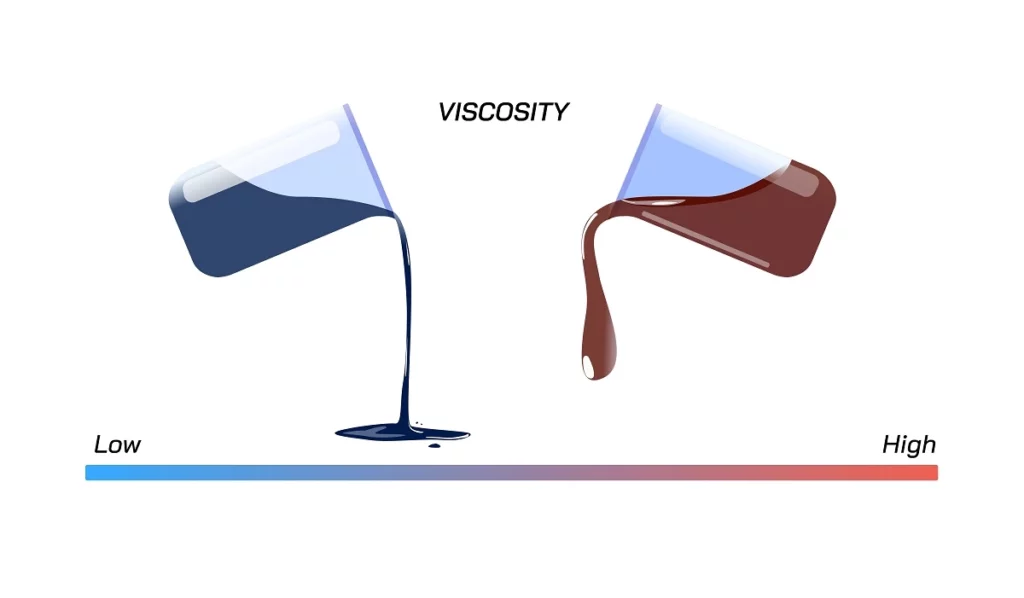When it comes to the smooth functioning and longevity of automotive engines, proper lubrication plays a crucial role. Among the various factors that contribute to effective lubrication, oil viscosity holds a significant position. Understanding oil viscosity is essential for ensuring optimal engine performance and protection.
Viscosity, in simple terms, refers to the thickness or resistance to flow of a fluid. In the context of automotive lubricants, oil viscosity determines how effectively the oil can lubricate the engine components, reduce friction, and dissipate heat. The viscosity of oil is not a one-size-fits-all concept, as it varies depending on the operating conditions and temperature range an engine experiences. In this guide, we’ll discuss everything you need to know about oil viscosity and how it affects the operation of your car’s engine.

Understanding Lubrication in Automotive Engines
Effective lubrication is vital for the smooth operation and longevity of automotive engines. Lubricants, such as oils, act as a protective barrier between moving parts, reducing friction and wear. This not only improves efficiency but also prevents damage that can result from metal-to-metal contact.
In an engine, there are numerous components, such as pistons, bearings, and camshafts, that rely on lubrication to function properly. Without proper lubrication, these components can experience excessive wear, heat buildup, and even failure.
Lubricants perform several crucial functions in an engine:
- Friction Reduction — By forming a thin film between moving parts, lubricants minimize the resistance to motion, reducing friction and energy loss.
- Wear Protection — Lubricants create a protective layer that prevents direct contact between metal surfaces, minimizing wear and extending component life.
- Heat Dissipation — Lubricants help dissipate heat generated by engine operation, preventing overheating and maintaining optimal operating temperatures.
- Contaminant Suspension — Lubricants also carry away and suspend contaminants, such as dirt, debris, and combustion byproducts, preventing them from causing damage.
It is important to note that different engine designs, loads, and operating conditions require different types of lubricants. One critical characteristic of lubricants that affects their performance is viscosity.
Now that we understand the role of lubrication in automotive engines, let’s explore the concept of viscosity and its significance in automotive lubricants.
What is Viscosity?
Viscosity refers to the resistance of a fluid to flow. In the context of automotive lubricants, it determines the thickness or consistency of the oil. Understanding viscosity is crucial because it directly affects the oil’s ability to flow and provide effective lubrication.
Viscosity is influenced by the internal friction of the fluid and the cohesive forces between its molecules. The higher the viscosity, the thicker the oil, and the greater the resistance to flow. Conversely, lower viscosity indicates a thinner oil with lower resistance to flow.
The viscosity of an oil is typically measured and specified at different temperatures. This is because viscosity changes with temperature variations. As temperature increases, the viscosity of most fluids, including oils, tends to decrease. Similarly, as temperature decreases, viscosity tends to increase.

To classify oil viscosity, various grading systems are used, with the most common being the Society of Automotive Engineers (SAE) viscosity grades. The SAE viscosity grades are represented by a numerical code, such as 10W-30 or 5W-40, where the numbers indicate the oil’s viscosity at different temperatures.
The “W” in the SAE code stands for winter, and it represents the oil’s viscosity at low temperatures. The lower the number preceding the “W,” the better the oil’s flow at cold temperatures. The second number represents the oil’s viscosity at higher temperatures, indicating its resistance to flow when the engine is running at operating temperatures. As an example, Motul 8100 Eco-Clean 0W-30 flows better in cold conditions than Motul 8100 X-Cess 5W-40. However, the latter offers better viscosity in hot climates.
Multigrade oils, denoted by a dual-viscosity rating like 10W-30, are designed to provide optimal viscosity across a wider temperature range. These oils offer easier cold starts (lower W number) while maintaining proper lubrication at high operating temperatures (higher second number).
The Impact of Oil Viscosity on Engine Performance:
The viscosity of the oil used in an engine has a profound impact on its overall performance. It affects crucial aspects such as lubrication efficiency, engine protection, fuel economy, and even cold-start capability. Let’s delve into the key factors influenced by oil viscosity:
Temperature and Lubrication
Engine temperatures vary significantly during operation. Oil viscosity must be carefully selected to maintain optimal lubrication across these temperature ranges. If the oil’s viscosity is too high, it may struggle to flow freely at lower temperatures, leading to inadequate lubrication during cold starts. Conversely, if the viscosity is too low, the oil may thin out excessively at high temperatures, reducing its ability to provide sufficient lubrication and protection.
Friction and Wear
Proper lubrication is essential for reducing friction between engine components. High-viscosity oils create a thicker protective film, reducing metal-to-metal contact and minimizing wear. However, excessively high viscosity can result in increased drag, potentially impacting fuel efficiency. Low-viscosity oils, on the other hand, flow more easily, reducing drag but potentially compromising wear protection, especially under high loads or extreme operating conditions.
Fuel Economy
Oil viscosity directly influences an engine’s fuel economy. Lower viscosity oils typically offer reduced internal friction, allowing for smoother and more efficient engine operation. This can contribute to improved fuel efficiency. However, it’s important to strike the right balance, as excessively low viscosity oils may not provide adequate protection under certain operating conditions, potentially leading to increased wear and reduced engine life.
Cold-Start Performance
During cold starts, the oil must flow quickly to critical engine components to provide immediate lubrication. This is particularly important as the engine experiences the highest wear during startup. Oils with lower viscosity ratings, denoted by a lower W number in the viscosity grade, offer better cold-start performance by flowing more readily at lower temperatures.
Manufacturer Recommendations
Automotive manufacturers provide specific recommendations regarding oil viscosity for their engines. These recommendations are based on extensive testing and engineering to ensure optimal performance and longevity. It is crucial to follow the manufacturer’s guidelines to maintain warranty coverage and maximize engine performance.
Oil Viscosity Grades and Specifications

When it comes to selecting the right oil for your engine, understanding oil viscosity grades and specifications is essential. Let’s explore the different aspects related to oil viscosity grades:
Viscosity Grade Classification System
As mentioned earlier, the Society of Automotive Engineers (SAE) viscosity grade classification system is widely used to categorize oils based on their viscosity characteristics. The viscosity grade is represented by a combination of numbers, such as 5W-30 or 10W-40. The first number followed by the “W” (which stands for winter) indicates the oil’s viscosity at low temperatures. The second number denotes the oil’s viscosity at higher temperatures.
Multigrade Oils
Multigrade oils, such as 5W-30 or 10W-40, are designed to provide optimal viscosity performance across a wide range of temperatures. They offer improved cold-start flow characteristics (lower W number) while maintaining proper viscosity at higher operating temperatures (higher second number). Multigrade oils are commonly recommended by vehicle manufacturers due to their versatility and ability to adapt to varying climates and operating conditions.
Single-Grade Oils
Single-grade oils, also known as monograde oils, have a single viscosity rating. For example, Motul SAE 30 or Motul SAE 50. These oils have a fixed viscosity that remains relatively constant across different temperatures. Single-grade oils are typically used in specific applications where a constant viscosity is required, such as in older engines or certain industrial equipment.
OEM Recommendations and Specifications
Vehicle manufacturers provide specific oil viscosity recommendations for their engines. These recommendations are based on extensive testing and engineering to ensure optimal performance, efficiency, and engine longevity. It is important to refer to the owner’s manual or contact the manufacturer to determine the recommended oil viscosity grade for your specific vehicle.
Industry Standards and Certifications
Various industry standards and certifications, such as API (American Petroleum Institute) and ACEA (European Automobile Manufacturers Association), define the performance requirements and specifications for different oil viscosity grades. These standards ensure that the oils meet specific quality and performance criteria, further aiding in the selection of appropriate lubricants.
When selecting the right oil viscosity grade, consider factors such as the climate in which you will be operating the vehicle, the manufacturer’s recommendations, and the specific engine requirements. Choosing the correct oil viscosity grade will help ensure optimal engine protection, performance, and longevity.
Factors Affecting Oil Viscosity
Several factors can influence the viscosity of automotive lubricants. It’s important to consider these factors when selecting an oil for your vehicle. Let’s explore the key factors that can affect oil viscosity:
Base Oil Type
Different base oil types, such as mineral oil, synthetic oil, or semi-synthetic oil, can have varying viscosity characteristics. Synthetic oils, for example, often exhibit more consistent viscosity across a wide temperature range compared to mineral oils. Understanding the base oil type and its viscosity properties can help in choosing the right oil for specific operating conditions.
Additives
Lubricating oils may contain additives that enhance their performance and viscosity stability. These additives can affect the viscosity characteristics of the oil. For instance, viscosity index improvers are additives that help stabilize viscosity across a range of temperatures. Anti-wear additives and detergents are other examples of additives that can influence oil viscosity.
Temperature
Temperature plays a significant role in oil viscosity. As temperature increases, most oils thin out and exhibit lower viscosity, making them flow more easily. Conversely, at lower temperatures, oils tend to thicken and show higher viscosity. It’s crucial to select an oil viscosity grade that matches the expected temperature range for optimal engine protection and lubrication.
Pressure and Shear Rate
High-pressure environments and shear rates, such as those experienced in certain engine components like the bearings or piston rings, can affect oil viscosity. Under extreme pressure and shear, oils may temporarily thin out, resulting in lower effective viscosity. This phenomenon, known as shear thinning, should be considered when selecting oils for engines operating under such conditions.
Oil Condition and Aging
Over time, oils can degrade and undergo changes in viscosity due to factors such as oxidation, contamination, and thermal breakdown. As the oil ages, its viscosity characteristics may alter, potentially impacting its ability to provide adequate lubrication. Regular oil analysis and oil changes can help monitor the condition and viscosity of the oil, ensuring optimal engine performance.
Choosing the Right Oil Viscosity

Choosing the appropriate oil viscosity is crucial for maintaining the health and performance of your engine. Here are some practical tips to help you select the right oil viscosity for your vehicle:
Follow Manufacturer Recommendations
Always refer to the vehicle manufacturer’s recommendations for oil viscosity. The manufacturer’s specifications take into account the specific engine design, operating conditions, and performance requirements. Following their guidelines ensures compatibility, optimal performance, and warranty coverage.
Consider Climate and Operating Conditions
Take into account the climate in which your vehicle operates. In colder climates, oils with lower W numbers (e.g., 0W, 5W) offer better cold-start performance. In hotter climates or under high-load conditions, oils with higher second numbers (e.g., 40, 50) provide enhanced protection at higher temperatures. Most car manufacturers will provide a graph of acceptable viscosity values for their engines based on your climate. Understanding the climate and the demands placed on your engine will help you select an appropriate viscosity grade.
Seek Professional Advice
If you are unsure about the right oil viscosity for your vehicle, consult with a trusted mechanic or oil expert. They can provide personalized recommendations based on your specific vehicle, usage patterns, and local climate.
Monitor Oil Condition
Regularly check your oil’s condition and viscosity by following the recommended maintenance intervals. Perform oil analysis if necessary to assess its viscosity and detect any potential issues. If the oil has degraded or its viscosity has changed significantly, it may be time for an oil change or further investigation.
Frequently Asked Questions about Oil Viscosity:
Q1: Can I use a different viscosity oil than what is recommended by the vehicle manufacturer?
It is generally recommended to follow the oil viscosity guidelines provided by the vehicle manufacturer. The manufacturer’s recommendations are based on extensive testing and engineering to ensure optimal performance and longevity of the engine. Using a different viscosity oil may lead to inadequate lubrication, increased wear, and potential engine damage.
Q2: What happens if I use oil with a higher viscosity than recommended?
Using oil with a higher viscosity than recommended can result in increased internal friction, reduced fuel efficiency, and potential strain on engine components. The thicker oil may not flow as easily, especially during cold starts, which can lead to poor lubrication and increased wear. It is best to stick to the recommended viscosity grade for optimal engine performance.
Q3: Can I switch from a mineral oil to a synthetic oil with a different viscosity?
Yes, it is generally possible to switch from a mineral oil to a synthetic oil with a different viscosity. However, it is important to ensure that the synthetic oil meets the required specifications and standards for your vehicle. Synthetic oils often provide better viscosity stability across temperature ranges and enhanced protection, but it is advisable to consult the vehicle manufacturer’s recommendations and seek professional advice if needed.
Q4: How often should I check my oil viscosity?
It is recommended to check your oil viscosity regularly as part of routine maintenance. Follow the oil change intervals and guidelines provided by the vehicle manufacturer. During oil changes, you can assess the oil’s viscosity and condition. Additionally, if you notice any significant changes in engine performance, unusual noises, or oil leaks, it is advisable to check the oil viscosity promptly.
Q5: Does oil viscosity affect fuel economy?
Yes, oil viscosity can have an impact on fuel economy. Lower viscosity oils, such as those with lower second numbers in the viscosity grade, generally reduce internal friction, leading to improved fuel efficiency. However, it is essential to strike a balance and select the appropriate viscosity grade that provides adequate engine protection and meets the manufacturer’s recommendations.
Remember, if you have specific questions or concerns about oil viscosity and its impact on your vehicle, it is always recommended to consult with professionals, such as mechanics or oil experts, who can provide personalized advice based on your vehicle’s requirements and operating conditions.
Find Motul Oils For Your Engine
Understanding oil viscosity is essential for any vehicle owner or enthusiast. Oil viscosity plays a vital role in engine lubrication, friction reduction, and heat dissipation. By grasping the concept of viscosity, recognizing the impact of different oil viscosities on engine performance, and considering factors such as temperature, pressure, and oil condition, you can make informed decisions when choosing the right Motul oil for your car!
Whether you live in a cold climate, drive under extreme conditions, or seek improved fuel economy, selecting the appropriate oil viscosity grade is crucial. Always refer to the vehicle manufacturer’s recommendations, consult professionals when needed, and prioritize the health and performance of your engine by adhering to proper maintenance practices.





